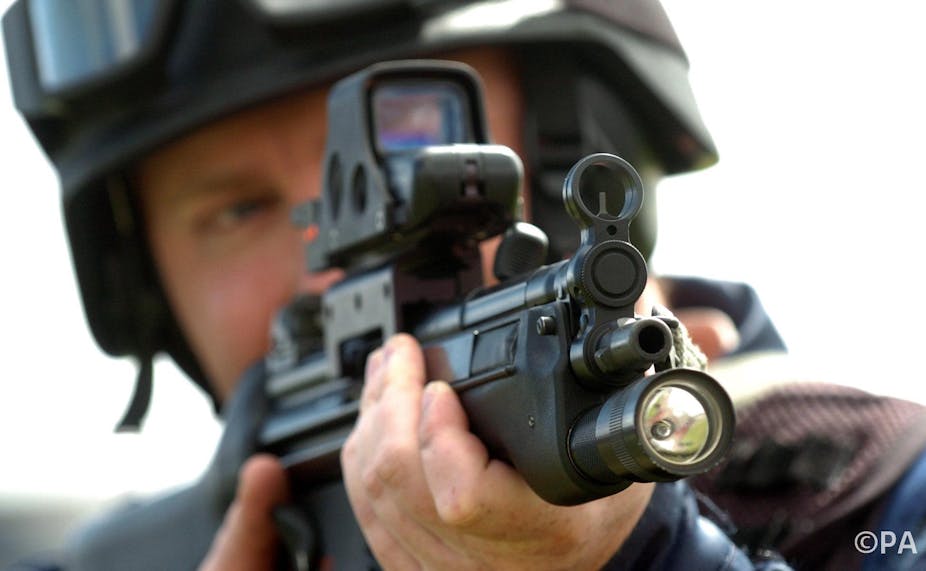Here’s a figure that deserves some attention: in the first year in which Scotland had a single police force, 8,000 stop searches were carried out by armed response officers, an average of 29 searches by each of the 275 officers involved. This does not happen in England and Wales, since armed response officers do not carry out routine duties.
This eye-watering statistic was cited in the Scottish police inspectorate’s recent review of armed policing, but it was not a key finding. Instead it was cited in passing in a paragraph commenting on the value of armed response vehicle (ARV) officers undertaking routine policing duties.
The inspectorate clearly sees the use of stop and search by armed response officers as a matter of everyday policing, thereby echoing the Police Scotland view that it would be a “waste of valuable resource if they [ARV officers] didn’t continue with core duties”. Routine crime control, as it were.
It’s a seemingly pragmatic position, but it arguably misses the larger point. The presence of a 9mm sidearm significantly changes the dynamics of police-public interaction. In short, it’s no longer routine policing at all.
Stop and search: some context
Police with firearms make stop and search more intimidating. And there’s a risk of escalation and things going wrong. And above all, armed policing sits uneasily with the distinctive profile of stop and search in Scotland.
Stop and search is under-regulated in Scotland. Unlike England and Wales, where all stop searches must have legislative grounds, officers in Scotland can stop and search people on a non-statutory basis, meaning that they only have to give verbal consent. This means these searches are not based on legal authority. They don’t require reasonable suspicion, nor indeed any standard of suspicion.
Now given that 70% of recorded searches in Scotland are non-statutory, it seems fair to suggest that some of the 8,000 stop searches undertaken by armed response officers were without legal authority. This is a deeply unsettling prospect in itself – never mind the fact that the presence of a visible firearm arguably undermines any meaningful idea of consent.
The use of armed response officers on routine duties also sits uneasily with the age profile of stop and search, which tends to be weighted towards children and young people. In the first year of Police Scotland, approximately 640,000 stop searches were recorded.
Of these, 36% were carried out on young people and children aged 19 years and younger; and 11% were carried out on children aged younger than 15. The peak age for stop and search is typically 16. These statistics suggest that at least some of the stop searches by armed response officers involved children and young people – again an unsettling prospect.
The larger point here is that policing doesn’t fall equally across the population, or even across local communities. Policing is more likely to coincide with more vulnerable sectors of society, with deprivation, and with people who tend not to have a voice. This makes the prospect of being stopped and searched by an armed response officer even more problematic.
Under fire
There may or may not be an important caveat to this. On October 1 2014, following a major political and media brouhaha, the chief constable in Scotland announced that armed response officers would no longer be deployed on routine duties, though the standing authority for Scottish officers using firearms would remain in place.
Various reviews are underfoot, however, which suggests that the jury may still be out. In addition to the recent report for the inspectorate, which was favourable towards armed officers, an internal review into armed policing is underway, due to report in January 2015. The Scottish Police Authority is also carrying out an ongoing review to assess public concerns over firearms officers on routine patrol, and “how Police Scotland might best address any public concerns”.
In the meantime the police inspectorate has recommended armed response officers should be allowed to undertake routine duties, subject to local consultation. It said that Police Scotland and the Scottish Police Authority should re-engage with local authorities and other relevant groups to develop criteria for armed response officers to undertake non-firearm duties that would allow them to meaningfully contribute to local policing priorities.
Should Police Scotland and the Scottish Police Authority do this? It may be inadvisable. There’s the delicate matter of public confidence and support to consider. To date, the inception of Police Scotland has not been straightforward. The single police force has received an unprecedented (and arguably overdue) degree of political and media scrutiny, casting a critical spotlight on policies and practices that previously passed beneath the radar.
This has included a wider sense of disquiet around centralisation, lack of local input, weak accountability, and more rigid performance-management methods – all of which will have been noted in England and Wales, which is expected to pursue a similar model. Deploying firearms officers on routine duties in Scotland has fed into the same deeply politicised narrative. In this context, armed stop and search does not look wise. Scotland’s police authorities would be advised to give this some serious reflection.

